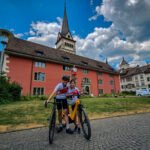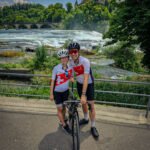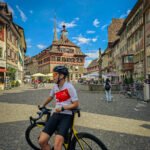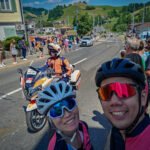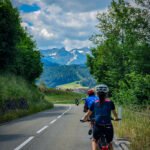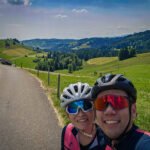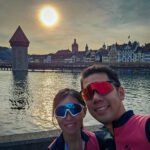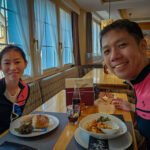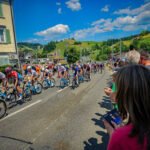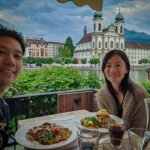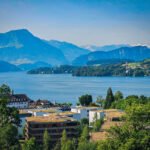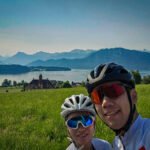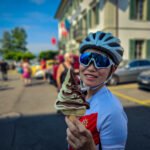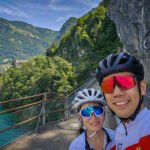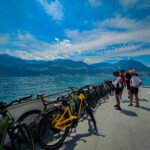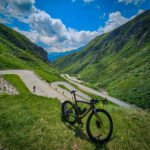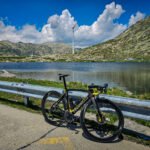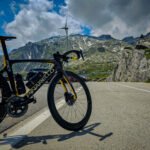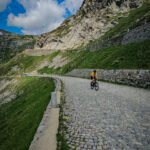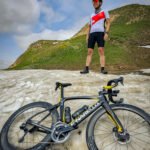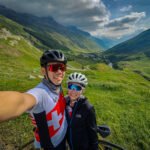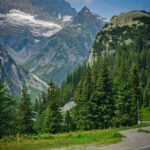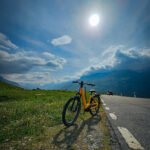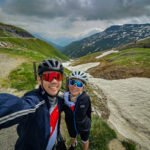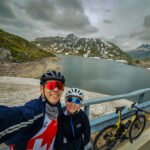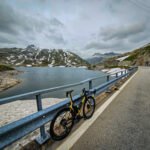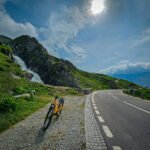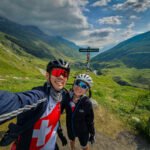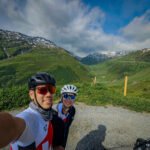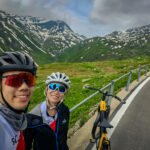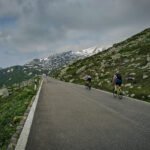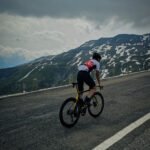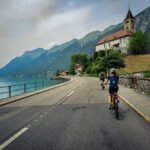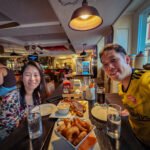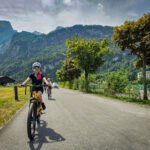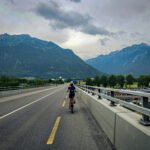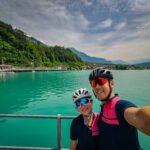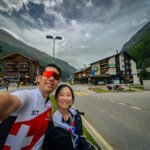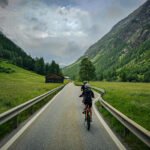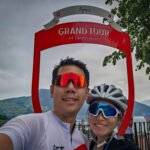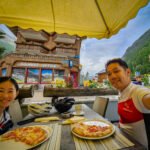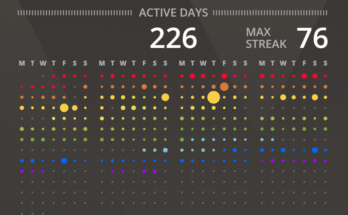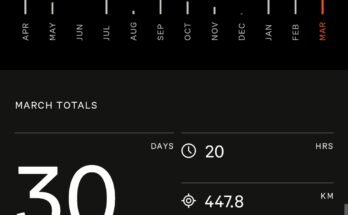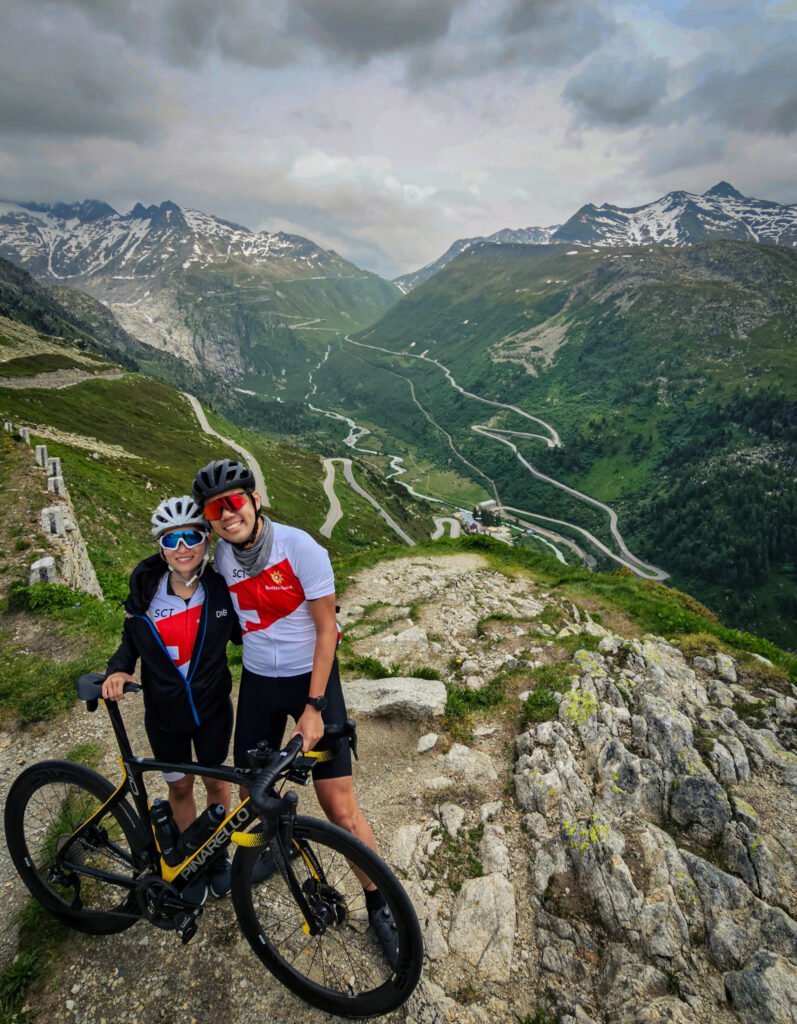
Almost exactly a year ago, I descended into Switzerland via Stelvio, Italy. My sojourn in Switzerland lasted no more than an hour but the view was captivating. Captivating enough to landed in Zurich a year later, together with my wife. Our Swiss itinerary was very different from Italy. Instead of consecutive days of climbing in Italy, our routes were more varied. A mix of city tours, intercity journeys and of course, climbs. We also extended our trip by a week. This meant a week of cycling and a week of normal tourist-ing with family members. Here is a quick summary video of the cycling leg of the trip. The long read follows below.
Day 1: Rhine Falls & Lake Constance
- The first day was relaxing. A good introductory ride after a 12-hour flight. There was a mixture of roads and cycling paths.
- We began with lunch before proceeding to set up our bikes. Every lesson learnt from previous cycling trips made setting up the bike a breeze. I was glad that I packed my DI2 charger because the battery was flat on arrival. There must have been significant temperature variation in the plane’s cargo hold because one of my small bags was clearly exposed to high heat while other items landed cold. This might have caused the incredibly quick battery drain. It is hard to explain otherwise given that the battery was disconnected from the bike when packed. 20 mins with a power bank and the bike had enough to last more than a day. A DI2 charger is now a must bring.
- My wife was on a rental e-bike and found it easy to get adapted. It was a city bike. Riding position was upright and comfortable. Even though it easily weighed >15kg, the battery life was incredible. My wife could put the bike on turbo all day and still have half the tank full at the end of each day. This included going up climbs.
- The highlight of the day was definitely Rhine Falls. Picturesque and powerful, we decided to return to the falls a week later so that our family members could experience it.
- We then followed the river towards Lake Constance and stopped by a town for snacks. Gelato, of course. The design of most Switzerland towns, especially in the northern region, are German influenced. And it is beautiful. My wife remarked that many of the buildings reminded her of drawings from fairy tale books. It reminded me of Canazei. Great holiday vibes.
- We continued along the lake for the next half the journey, taking in the views and fresh air. I really enjoyed the cooler temperature and significantly lower humidity vis-à-vis Singapore. These are conditions you can ride for hours without sweating.
Day 2: Appenzell – Urnasch – Wattwell
- My flu unfortunately worsened overnight. As updated previously, I had flown with a cold, which started three days prior. My flus tend to last between 7 to 10 days, so I was quite concerned that the entire cycling leg of the trip would be affected.
- The second day began with a train ride to the start point at Teufen. We would quickly reach Appenzell, a quaint town with fairly traditional practices, including in-person referendums and town halls.
- We enjoyed a gentle start, descending from around 850m to 750m. There was a short climb of around 100m over 1.4km with an average gradient of 7.1%, before another long descent brought us from 925m back to 800m.
- And then, we waited for an hour… to catch the Tour de Suisse! It was my first time catching a world tour live. There were some surprises including a convoy of promotional cars that arrived before the riders. Staff in the cars handed out goodie bags, food and merchandise from race sponsors to those at the roadside waiting for the arrival of the cyclists. The peloton soon came after and I was surprised to see how tightly packed it was. I now understand why crashes can easily happen in pro tours. It is pretty insane to have to keep such a tight formation at high speeds.
- It was also poignant time of the tour as pro cyclist Gino Madder had passed just a day prior, after falling into a ravine two stages before.
- The first notable climb came after. Starting at 855m, we climbed 205m up till 1060m spread over 3.4km with an average gradient of 5.9%. There were some groans. We entered grassy rolling plains dotted with small houses and cattle. Always helps to have a refreshing view when spinning uphill.
- Following a decent of close to 6km, we kicked on for a second climb – 185m over 2.1km at 8.6%. I felt the effects of riding with a flu especially on the second ascent but managed to clear it fairly smoothly.
- A descent from 900m to 600m followed and we boarded a train at Wattwell to spend the night at Lucerne.
- This was a good route to warm the legs up the climbing days ahead.
Day 3: Lucerne
- This felt like a true city tour mixed with scenic roads along the lake. We rolled through the city centre past historical sites and soon made our way to a nearby town.
- As luck would have it, there was a vintage car exhibition which consisted of mostly American cars. We took a stop to wander around and have… gelato, of course. It was fairly warm with temperatures between 22-25 degrees Celsius.
- We went from town to town, stopping to take in the sights, pick up food and have a picnic.
- The best sights came from the winding roads along the lake. We even got on the boat with our bikes to cross the lake.
- This was a enjoyable leisure day which gave the group a bit of everything – a fairly long ride around 60km, a huge variety of views, multiple stops to grab a bite and a boat ride. I think this might have been the only overseas leisure city tour I have done on a bike.
- My only issue was that my flu was building to its peak. By the time noon arrived, I was feeling out of sorts. Post nasal drip was at full swing and I had to clear my throat fairly often. The sun was strong, which was great unless you have a flu and prefer much cooler weather.
- Post ride, we decided to tour the city. This would be our last day in Lucerne and I was keen to make the most of it, but the flu made things difficult. We took a walk on the historic long bridge, visited the cultural sights and had a good meal.
Day 4: Airolo – Gotthard Pass – Andermatt
- My flu finally let up. I had a long sleep and it paid off. I felt a lot fresher though slightly concerned about the first of three major climbing days.
- We took a train to the foot of the day’s climb. This was a climb not to be missed – uphill on cobbles. A road steeped in history, used by cattle drawn carts in the past and maintained to this day.
- We began at around 1289m and began a 12km ride up to 2200m. A total of 911m of climbing at an average gradient of 7%.
- The gradient and distance was moderately punishing as compared to previous climbs in Italy but what made things tough were the cobbles.
- It began with short cobbled sections at around 400m intervals. I thought that was all. An experience of getting your arms and butt bumping around, all while your legs are grinding slowly uphill. At around the 4km mark, the cobbles disappeared and I asked our local guide if that was it. “Oh no the last 6km is entirely on cobbles.” Dang.
- And so it began, I wished I had something wider than the 25mm tires which was my Dogma F10’s limit. Rattling along the cobbles began as a novelty but soon turned into a challenge.
- I regretted not working on out-of-saddle form as it would have helped massively here. Pedal stroke after pedal stroke I cleared the switchbacks. The view helped. I did not want to rest too much because I wanted to clear the cobbles.
- The summit came to view and I was relieved. I love summit views, the first of this trip. Having a bird’s eye view of mountains and valleys is amazing.
- I was glad my flu had let up today. It would have been much much worse otherwise.
- After grabbing a bite, we descended back down to around 1470m and made our way to Andermatt. It was our best accommodation of the trip and a welcome rest from the first climbing day.
Day 5: Andermatt – Furka Pass – Gletsch – Grimsel Pass – Meiringeng
- I woke up feeling rather poorly but had to get through the longest ride of the trip, and with double ascents.
- We enjoyed a warm ride to the base of Furka Pass before embarking on the climb. The climb would see us ascend around 890m from 1610m to 2500m at an average gradient of 7.7% over 11km. It would be very similar to the day before minus the cobbles. That was a big bonus.
- I paced my climb too conservatively. I was not feeling well and had the second climb in mind. I was also wearing too many layers as the day started off cold, and had to remove my jacket midway.
- My wife paced me up the climb and she was truly enjoying her e-bike. She made several laps up and down around me to capture the moments.
- Furka is a beautiful climb. My leisurely pace made it possible for me to take in the views.
- I knew I had paced it too slow when I started to feel that I did not have enough fuel. That was enough for me to push the pace a little and get to the top.
- I stood on snow at the top! It was just a large patch but that was probably my first physical contact with snow.
- A hot chocolate later we made a descent back down to 1770m to begin the second climb.
- Grimsel Pass is a much shorter climb. Had I realised this earlier, I would have pushed the pace on Furka. It was just about 385m of climbing over 5km with an average gradient of 7.6%. More or less half of Furka. We would summit at 2155m.
- After Gotthard and Furka, Grimsel felt like a breeze. The switchbacks made the route enjoyable. Switchbacks provide excellent views and also break the climb into bite-sized chunks. Before we knew it, we crested the top.
- And then began the longest descent I had ever experienced. 26km from 2155m to 620m with an average gradient of -5.7%. It was wonderful. I felt like I was floating through a postcard.
- We took a brief stop at the iconic hotel before continuing the descent. There were some challenges like strong crosswinds and the fact that almost all of us were new to long descents. We took breaks before we hit the base at Meiringeng.
- Unfortunately, the flu was relentless. My wife’s flu took a turn for the worse and our local driver helped send both of us to the hotel, while the rest boarded a train to Interlaken.
Day 6: Brienz – Meiringen – Interlaken
- This is now turning into a “how’s your flu” blog post. My wife woke feeling a lot better after >12 hours of sleep. I was feeling slightly better myself.
- I had some concerns about the route. There was going to be a major climb, one that the guides recommended we took the van to start the climb midway. I tend to lean towards an “all or nothing” approach and was tempted to do the entire climb. But my flu was a major consideration. My legs felt ok but I was not too sure if I would be able to make the full climb within an acceptable time frame. We left the decision for later.
- After a train ride to Brienz, we cycled to Meiringen. It was on quiet country-like roads. We rode past a few sheds with the mountains by our side. There were waterfalls to gawk at too.
- We reached Meiringen and it was decision time. I decided not to do the full climb. The rest decided similarly too. But we soon found out that our decision did not matter because there was an oncoming storm that would hit the route in a few hours. Riding up in the rain was on no one’s holiday list and descending in wet conditions would be dangerous.
- Regretfully, we decided to change plans for the day. There would be no magical descent into Grindelwald. Instead we decided to head back, all the way to Interlaken without taking the train. It would be a recovery day.
- The ride along Lake Brienz was really scenic. Temperatures had dipped a little and the sky was slightly overcast with the oncoming storm. I love atmospheres like this – brooding yet calm and intriguing.
- We tapped out close to 50km for the day though it felt effortless.
- We had the entire afternoon ahead of us. And most of us took the train to Grindelwald. My wife and I did the same and took the opportunity to scout out locations for the second leg of the trip including Jungfraujoch and Harder Kulm.
Day 7: Interlaken – Spiez – Tasch – Zermatt
- The final day of cycling. How quickly time flew. It was going to be a short day with the main aim of riding into Zermatt – the town that claims to be the home of the Matterhorn.
- My wife and I were feeling much better. The flu seemed to be passing. If only it had passed a week earlier.
- We rode from Interlaken to Spiez, a short leisure ride of around 17km. Thereafter, we boarded a train to Tasch and had lunch there. My wife finally fulfilled her craving of having pizza as we stopped at an Italian place.
- Our bikes arrived and it was time to hit the final stretch – just 5km into Zermatt. A minor climb of around 151m. We were already at 1450m and would be ending the trip at 1600m.
- As we got past the initial flat portion of the ride, the clouds started rolling in. As the first drops of a light drizzle set in, I decided to pick up the pace to avoid the rain as far as possible.
- It was a fairly short punchy climb. There was slight headwind but the main issue was the light rain, which when carried at strong wind speeds, resulted in stinging droplet splashes.
- Adding to that, we crossed a section where some construction work was going on. It was unfortunate as rain with dust is far from desirable. We picked up speed and flew past the section.
- We reached our destination in Zermatt in no time. A nice, cosy hotel with great views of the Matterhorn. We had to wait for 12 hours for the skies to clear to view it.
- Riding into a warm hotel in the middle of the rain surrounded by German inspired holiday architecture was a scene straight out of a fairy tale book. A fitting end to a great cycling trip!
Reflections
What went right
- Itinerary was perfect for a couple ride, especially the mix of routes and visiting several towns. Breaks in between for light touring on foot (or by train) made the trip more appealing for non-cycling enthusiasts like my wife.
- E-bike was a great choice for my wife. I was tempted to try it as well. My wife said that the rides were effortless. She could enjoy the scenery, food and company without worrying about physical strain. I can see e-bikes making cycling trips accessible to whole families. It is almost like riding a motorbike in beautiful places, albeit at a more leisurely pace and without needing a license.
- No longer needing high altitude sickness pills. I came into this trip without the pills and got through high altitudes fine. This included altitudes of over 3800m in the second leg of the trip. Glad to be rid of these!
- Tubolito tubes. I did not have to pump my tires after the initial bike setup. These tubes can really hold air well.
- Packing. Learnt from my mistakes overpacking for Italy. Everything was just right including clothes and tools. A good pedal wrench and my trusty Silca rachet and torque kit was enough to do everything. DI2 charger was a must have.
What went wrong
- The flu. Not that I could do anything about it. I am getting hit by more flu strains now that my kid is in school. I guess it is a rite of passage that will last 2-3 years.
- Training, weight and fitness. Well, there was hardly any pre trip cycling work due to my job and flu. But it did not affect me much, the itinerary was really forgiving.
- Conservative approach. What turned out to be a good thing for the Italy trip actually held me back for this one. I should have been a little more daring to expend more energy on some of the climbs. It would have reduced my activity/elapsed time allowing more time for recovery.
Thank you for sharing this journey with me and I look forward to having more trips to share! Many thanks to Alvin from Shangrila Cycling Tours (SCT), together with local guide Franz and driver Sepp, for making this possible. (And if you would like to take a look at the non-cycling leg of the trip, here are some photos and a video!)

